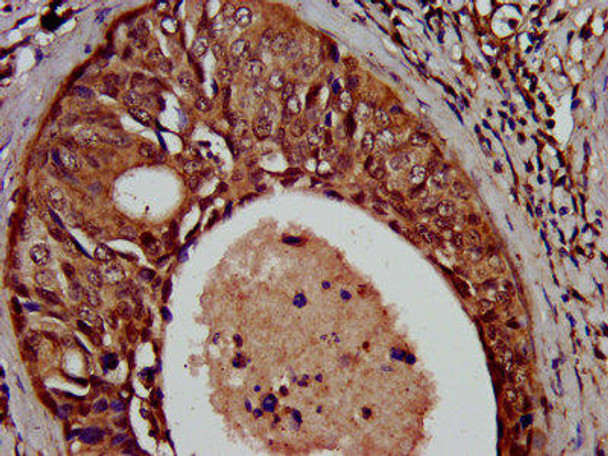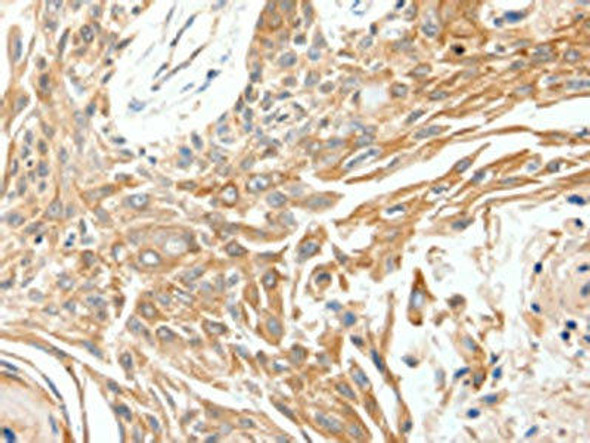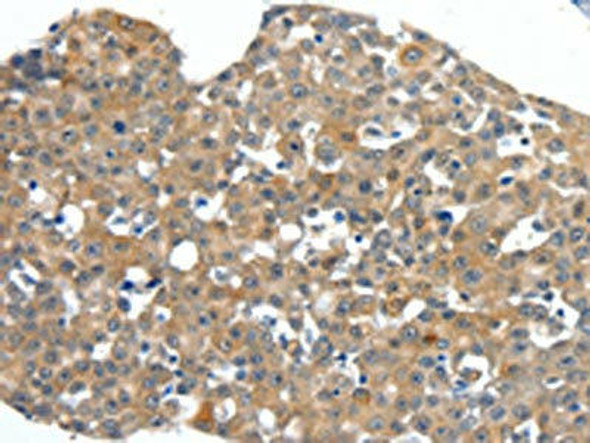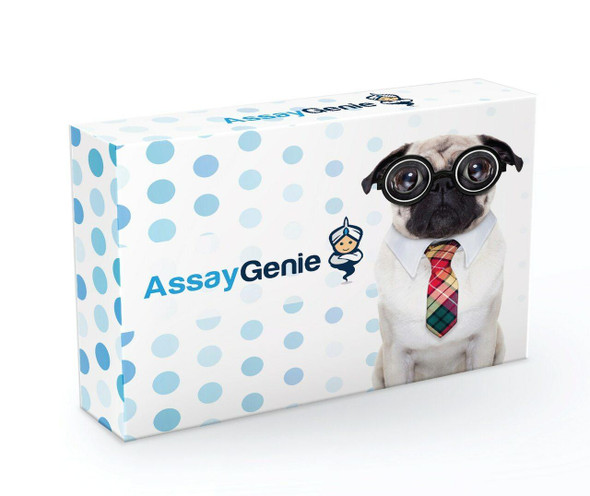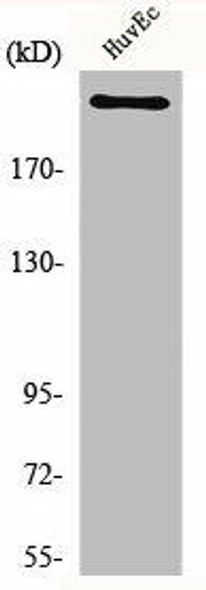Description
SCN11A Antibody (PACO58568)
The SCN11A Antibody (PACO58568) is a vital tool for researchers studying the SCN11A gene, which encodes for a voltage-gated sodium channel specifically expressed in sensory neurons. This antibody, produced through rigorous testing and validation, recognizes the SCN11A protein and can be used in various applications such as Western blotting and immunofluorescence.With its high specificity and reactivity towards human samples, the SCN11A Antibody is an essential asset for investigating the role of SCN11A in pain signaling, neuronal excitability, and sensory perception.
By targeting this sodium channel, researchers can gain insights into neurobiology, pain mechanisms, and potential therapeutic approaches for pain management.The unique properties of the SCN11A gene make it a promising target for drug discovery and development in the field of pain research. By utilizing the SCN11A Antibody, researchers can unravel the complexities of this gene's function and pave the way for novel treatments for chronic pain conditions and neurological disorders.
| Antibody Name: | SCN11A Antibody (PACO58568) |
| Antibody SKU: | PACO58568 |
| Size: | 50ug |
| Host Species: | Rabbit |
| Tested Applications: | ELISA, IHC, IF |
| Recommended Dilutions: | ELISA:1:2000-1:10000, IHC:1:500-1:1000, IF:1:50-1:200 |
| Species Reactivity: | Human |
| Immunogen: | Recombinant Human Sodium channel protein type 11 subunit α protein (403-551AA) |
| Form: | Liquid |
| Storage Buffer: | Preservative: 0.03% Proclin 300 Constituents: 50% Glycerol, 0.01M PBS, pH 7.4 |
| Purification Method: | >95%, Protein G purified |
| Clonality: | Polyclonal |
| Isotype: | IgG |
| Conjugate: | Non-conjugated |
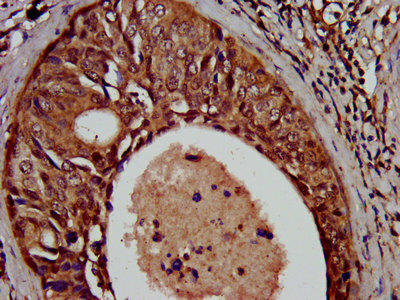 | IHC image of PACO58568 diluted at 1:500 and staining in paraffin-embedded human cervical cancer performed on a Leica BondTM system. After dewaxing and hydration, antigen retrieval was mediated by high pressure in a citrate buffer (pH 6.0). Section was blocked with 10% normal goat serum 30min at RT. Then primary antibody (1% BSA) was incubated at 4°C overnight. The primary is detected by a biotinylated secondary antibody and visualized using an HRP conjugated SP system. |
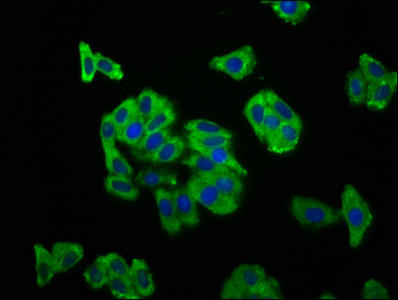 | Immunofluorescence staining of HepG2 cells with PACO58568 at 1:166, counter-stained with DAPI. The cells were fixed in 4% formaldehyde, permeabilized using 0.2% Triton X-100 and blocked in 10% normal Goat Serum. The cells were then incubated with the antibody overnight at 4°C. The secondary antibody was Alexa Fluor 488-congugated AffiniPure Goat Anti-Rabbit IgG(H+L). |
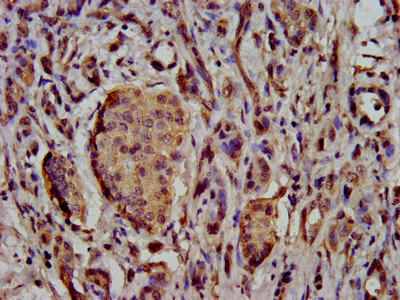 | IHC image of PACO58568 diluted at 1:500 and staining in paraffin-embedded human pancreatic cancer performed on a Leica BondTM system. After dewaxing and hydration, antigen retrieval was mediated by high pressure in a citrate buffer (pH 6.0). Section was blocked with 10% normal goat serum 30min at RT. Then primary antibody (1% BSA) was incubated at 4°C overnight. The primary is detected by a biotinylated secondary antibody and visualized using an HRP conjugated SP system. |
| Background: | This protein mediates the voltage-dependent sodium ion permeability of excitable membranes. Assuming opened or closed conformations in response to the voltage difference across the membrane, the protein forms a sodium-selective channel through which sodium ions may pass in accordance with their electrochemical gradient. It is a tetrodotoxin-resistant sodium channel isoform. Also involved, with the contribution of the receptor tyrosine kinase NTRK2, in rapid BDNF-evoked neuronal depolarization. |
| Synonyms: | Sodium channel protein type 11 subunit α (Peripheral nerve sodium channel 5) (PN5) (Sensory neuron sodium channel 2) (Sodium channel protein type XI subunit alpha) (Voltage-gated sodium channel subunit α Nav1.9) (hNaN), SCN11A, SCN12A SNS2 |
| UniProt Protein Function: | Function: This protein mediates the voltage-dependent sodium ion permeability of excitable membranes. Assuming opened or closed conformations in response to the voltage difference across the membrane, the protein forms a sodium-selective channel through which sodium ions may pass in accordance with their electrochemical gradient. It is a tetrodotoxin-resistant sodium channel isoform. Also involved, with the contribution of the receptor tyrosine kinase NTRK2, in rapid BDNF-evoked neuronal depolarization. Ref.1 Ref.3 |
| UniProt Protein Details: | Subunit structure: The voltage-resistant sodium channel consists of an ion conducting pore forming alpha-subunit regulated by one or more auxiliary subunits SCN1B, SCN2B and SCN3B. Subcellular location: Membrane; Multi-pass membrane protein By similarity. Tissue specificity: Expressed in the dorsal root ganglia and trigeminal ganglia, olfactory bulb, hippocampus, cerebellar cortex, spinal cord, spleen, small intestine and placenta. Ref.2 Ref.5 Domain: The sequence contains 4 internal repeats, each with 5 hydrophobic segments (S1,S2,S3,S5,S6) and one positively charged segment (S4). Segments S4 are probably the voltage-sensors and are characterized by a series of positively charged amino acids at every third position. Post-translational modification: Phosphorylation at Ser-1341 by PKC in a highly conserved cytoplasmic loop slows inactivation of the sodium channel and reduces peak sodium currents By similarity. Sequence similarities: Belongs to the sodium channel (TC 1.A.1.10) family. Nav1.9/SCN11A subfamily. [View classification] |
| NCBI Summary: | This proto-oncogene, highly-expressed in a variety of tumor cell lines, belongs to the sevenless subfamily of tyrosine kinase insulin receptor genes. The protein encoded by this gene is a type I integral membrane protein with tyrosine kinase activity. The protein may function as a growth or differentiation factor receptor. [provided by RefSeq, Jul 2008] |
| UniProt Code: | Q9UI33 |
| NCBI GenInfo Identifier: | 19924165 |
| NCBI Gene ID: | 6098 |
| NCBI Accession: | NP_002935.2 |
| UniProt Secondary Accession: | Q9UI33,Q15368, Q5TDB5, |
| UniProt Related Accession: | P08922 |
| Molecular Weight: | 263,915 Da |
| NCBI Full Name: | proto-oncogene tyrosine-protein kinase ROS |
| NCBI Synonym Full Names: | ROS proto-oncogene 1, receptor tyrosine kinase |
| NCBI Official Symbol: | ROS1 |
| NCBI Official Synonym Symbols: | ROS; MCF3; c-ros-1 |
| NCBI Protein Information: | proto-oncogene tyrosine-protein kinase ROS |
| UniProt Protein Name: | Sodium channel protein type 11 subunit alpha |
| UniProt Synonym Protein Names: | Peripheral nerve sodium channel 5; PN5; Sensory neuron sodium channel 2; Sodium channel protein type XI subunit alpha; Voltage-gated sodium channel subunit alpha Nav1.9; hNaN |
| Protein Family: | Protein |
| UniProt Gene Name: | SCN11A |
| UniProt Entry Name: | SCNBA_HUMAN |

